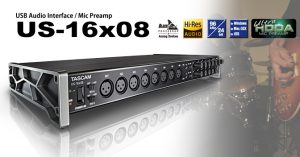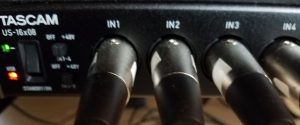So why, when I could have purchased a new synth, mic, sax, guitar….any new instrument…would I instead be investing in a Tascam 16×08 interface, for heaven’s sake?!
Well, the answer is as complex, and simple, as this: PLATFORM! This year I went to a totally different recording setup and needed an appropriate gateway to get all my audio into “the box”.
May not sound sexy, but…ya know… somehow it IS!

A Change Will Do Me Good
Since 2002 I recorded all my original music on the Roland VS-2480 hardware configuration. I recorded many a fine album on that gear, but this was the year things grew to the point where I needed more, so…
Now I sit here taking in the grand vista of a full-blown Pro Tools 12.8 system. And I’m loving it. Yea, there’s a HUGE learning curve, but I mean, come on: “Teaj, you’re gonna have to spend more time in the studio surrounded by all this great gear, making new music.” Cry me a river!!
Because I’m working ‘in the box’ now, however, I needed to invest in an audio and MIDI interface. If you don’t know, that’s the piece of gear that gets your sounds and MIDI information from your synth/keyboard into the computer.
In other words, if you’re going to stick a microphone in front of an instrument, the other end of the cable will need to plug into something!
That thing is called an “interface”. This gets it into the land where digital friends and gremlins fight and frolic and allows your sounds to show up on your computer monitor screen where you can mutate and cannibalize….uh, I mean, caress and edit them to your ear’s content.
For me there were two issues regarding interfaces that I had to answer before I bought one:
1) Quality and
2) inputs.
I knew, since I’m recording albums, that the interface I buy has to have good A/D conversion, come from a reputable company and basically have positive reviews from the online legions that have used it.
I also needed at least 8 inputs, because I like to track real, live drums (yes, those still ARE used in the studio!) instead of using loops or drum machines.
With those caveats in mind I did a 3 day search and kept coming back to this unit. It’s got great reviews, comes from a company with a long, rich, impressive history in pro audio and also has TEN inputs on its front, which is, of course, even better than eight. Why? Well, why does my amp go to eleven? The answer is obvious. 😉
My Preamp Primer
Tascam has always been a maker of high-end, dependable audio machinery. This 16×08 is another strong link in their chain of unendingly supplying us with stable, durable and ergonomic pro audio gear that helps us quickly and easily “get ‘er dun” in the studio.
Here’s the Spec list:
- Support for Windows & Macs
- USB 2.0 computer connection
- 8 Ultra-HDDA mic pres with XLR connectors, and 8 TRS inputs
- +48V phantom power onboard for all mic inputs
- Included software allows for assigning Outputs via the Digital Patch Bay
- Software features a DSP mixer with 4-band EQ & usable compression on each input channel
- Scenes can store DSP mixer settings (up to 10 scenes can be stored and named)
- Low-latency monitoring via on-board DSP mixer
- Confirmed & ongoing compatibility with major DAW software (SONAR, ProTools, Cubase, Live, Studio One, Garage Band)
- Up to 96kHz/24-bit recording
- Ultra-HDDA (High Definition Discrete Architecture) mic pres, with −125dBu EIN
- Enable “Standalone Mode” to use the 16×08 as an independent mic pre
- High-impedance inputs also available
- 56 dB of preamp gain available
- Eight TRS outputs
- Separate controls for Line Out, Headphones volumes
- Standard TRS headphones output jack with 70mW/ch output power
- Tough metal casing for durability
- MIDI input and output
- RoHS certified
- USB class compliant 2.0 support
- Angled design provides excellent usability on a desktop
- Connect with iPads and other iOS devices via Class Compliant drivers
- Dedicated AC adapter included
Signal’s Maiden Voyage!
Getting it up and running was easy. The manual was clear on how to hook up cables and everything worked as it was supposed to from the moment I turned it on.

I did have to learn how to finesse the BUFFER SIZE on it, depending on how I’m using Pro Tools, in order to get audio that didn’t click, pop and stutter. Once I understood how to set those parameters based on recording versus playback tho’ everything was gold.
In a nutshell, it gives good sound, is extremely versatile if you need to make channel/output/input changes, and the extremely useful and well-designed software program that comes with it is very handy. I keep it right next to my open Pro Tools window so I can make any changes on the fly, since all the parameters you could ever wish to change are displayed right there for you.
The basic EQ and Dynamics processing section, by the way, is intuitive and a great way to get a little mild compression on incoming signals, like toms or snare, right there on the front end before your sounds go into your computer.
I found both sections work well if you don’t tax them too much. The learning curve was mild, so you can get up and running with this unit in minutes.
The high amount of mic pre dB headroom in this unit makes it ideal for dynamic or ribbon mics, without introducing a bunch of terrorizing noise. I’ve never had a problem yet, especially with live drums, having enough rich, clean signal.
As soon as I narrowed down my interface search, my G.A.S. for this unit was BURNIN’! Thankfully, I found it for a great price on EBay new and somehow survived the four days it took for it to arrive. Now…it’s part of my recording family of electronic gadgetry, and I couldn’t be happier.
If a simple 2-in, 2-out interface just doesn’t cut it for you, as it didn’t for me, and if you want to be able, say, to track a whole band live in your studio, you’re going to to need a good number of inputs. The Tascam 16×08 gives you that, and so much more. And with the legacy dependability of the Tascam name, you know you’re going to be stay in good hands… session after session.
Got questions? You know where to find me. In the meantime, if you wanna join me in Tascam-land, here’s your link!:
See ya for our next post. In the meantime, plug in some ports, and go…make…sounds!
Teaj
